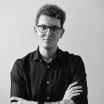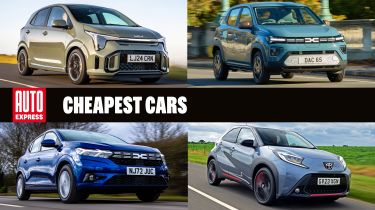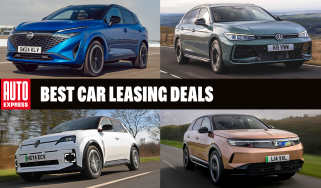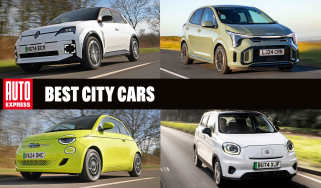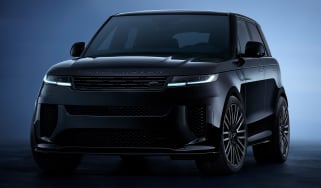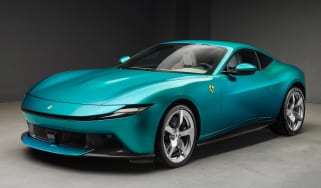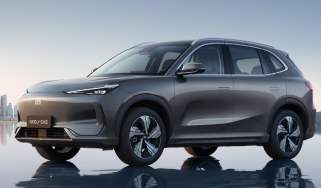Cheapest cars to buy 2025
Searching for a brand-new bargain? These are the cheapest cars in the UK right now
Not too long ago, if you were looking to buy one of the cheapest new cars in the UK, there was an underlying sense of ‘you get what you pay for’. These models may have seemed like a great deal, but the cost-cutting was obvious, to say the least. However, times have changed, and you can now look at these low-cost motors using both your head and heart.
There’s even more good news for savvy car buyers, because electric cars are finally starting to make their way on to our cheap cars countdown, too. This means that drivers who want to make the switch to electric and slash their running costs further can now do so without obliterating their bank accounts.
In order to determine which of the UK’s cheapest cars offer the biggest bang for their buck, our expert road testers have driven every single model that you’ll find on this list. Here we’ve ordered the top 10 cheapest new cars by price, but we also give you the lowdown on what they are like to live with and drive. Read on below and you might just find an absolute bargain.
Compare the cheapest cars on sale in the UK
Take a look at the table below to see our individual in-depth review ratings for each of the cheapest cars on sale right now, as well as each model’s efficiency score and, of course, starting price. Keep scrolling or click the links for our mini-review on each car...
| Cheapest cars to buy ranking | Name | Prices from | Efficiency, CO2 and running costs rating (out of 5) | Overall Auto Express star rating (out of 5) |
| 1 | Dacia Sandero | £14,715 | 4.4 | 4 |
| 2 | Dacia Spring | £14,995 | 4.8 | 3.5 |
| 3 | Leapmotor T03 | £15,995 | 4 | 4 |
| 4 | Dacia Sandero Stepway | £16,015 | 4.3 | 4.5 |
| 5 | Kia Picanto | £16,065 | 4 | 4 |
| 6 | Toyota Aygo X | £16,845 | 3.5 | 3.5 |
| 7 | Hyundai i10 | £17,100 | 4.2 | 4 |
| 8 | MG3 | £16,995 | 4.5 | 5 |
| 9 | Citroen C3 | £18,305 | 4 | 4 |
| 10 | BYD Dolphin Surf | £18,650 | 4.8 | 4 |
1. Dacia Sandero

- Prices from £14,715
Pros |
Cons |
|
|
The Dacia Sandero is a full-sized supermini that offers simplicity, comfort and surprising practicality for those who are after basic transport without any gimmicks. The interior is actually more spacious than many of the Sandero's supermini rivals, running costs are usefully low and the mechanicals have proven their worth in the past, so the Sandero should be reliable. Thanks to its Renault heritage, the latest Sandero shares a platform with the current Renault Clio – a much more expensive supermini.
This means the car’s chassis is more modern than in previous editions and it feels sophisticated to drive. Build quality can be questionable in places, but some of the engine line-up uses Renault’s latest fuel-saving technology, meaning the Sandero is surprisingly efficient and perky on the road.
“They say the most simple ideas are often the best, and despite not being one of those trendy small SUVs, Dacia’s well-judged, great-value supermini is right up there with the best in the class.” - Ellis Hyde, news reporter, who drove the Sandero in the UK
2. Dacia Spring

- Prices from £14,995
Pros |
Cons |
|
|
It’ll probably come as no surprise to see yet another Dacia on this list, but what may shock you is that this sub-£15,000 car is purely electric powered. That’s right, the Dacia Spring is the cheapest fully fledged electric car that you can now buy in the UK.
In order to keep the cost down, the Spring is a bit basic compared with most of its rivals, and the entry-level model will only cover up to 140 miles on the WLTP combined cycle. That being said, if you often find yourself zipping around city streets on shorter journeys, this should prove more than enough. There’s a reasonable amount of essential kit included, such as air-conditioning and rear parking sensors.
“The Dacia Spring makes a tempting case for itself, with its low price making it easier to overlook the flaws that often come with a car built down to a budget.” - Alex Ingram, chief reviewer, who tested the Spring in the UK
3. Leapmotor T03
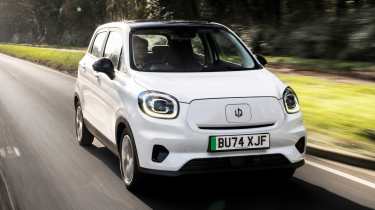
- Prices from £15,995
Pros |
Cons |
|
|
As part of efforts to increase its share on the budget car market, Stellantis has introduced the Leapmotor T03 to the UK. This Chinese city car is fully electric, and with a £15,995 starting price, it’s taking aim squarely at the Dacia Spring. With an official WLTP combined range of 165 miles, the Leapmotor does have a slight advantage when it comes to distance, and it comes with its fair share of standard kit, too.
It’s pretty tiny by modern car standards, but thanks to some clever design, the T03’s cabin can still accommodate four adults in reasonable comfort. It rides surprisingly well over poorer road surfaces, too.
“There are a few quirks to the driving experience, and it does look a little ungainly from some angles, but as a first step into EV ownership there’s really very little not to like about the T03.” - Richard Ingram, deputy editor, who tested the T03 in the UK
4. Dacia Sandero Stepway
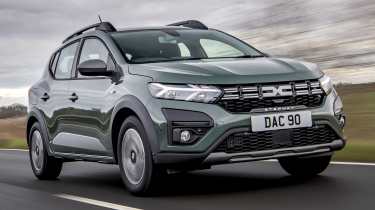
- Prices from £16,015
Pros |
Cons |
|
|
The Dacia Sandero Stepway takes the best bits of the standard Sandero and adds in more rugged SUV-style looks, a bit more space and extra features that bring the base Stepway more in line with mid-spec city car rivals; as opposed to the rather sparse nature of the standard Sandero.
The base Essential trim includes a DAB radio, Bluetooth, air-conditioning and cruise control as standard. You even have a choice of engines in the form of a petrol-powered TCe 90 or (at extra cost) the Bi-Fuel TCe 100. Both versions claim to return more than 45mpg, so running costs should prove affordable. With its 328-litre boot, the Sandero Stepway is an affordable family option, too.
“Although the Sandero Stepway is underpinned by the same CMF-B architecture as the Renault Clio, it uses a more rudimentary suspension setup. Ultimately, it doesn’t provide much in the way of driving fun, instead offering a focus on comfort which suits the car’s family bias,” - Ellis Hyde, news reporter, who drove the Sandero Stepway in the UK
Latest Dacia Sandero Stepway deals
5. Kia Picanto
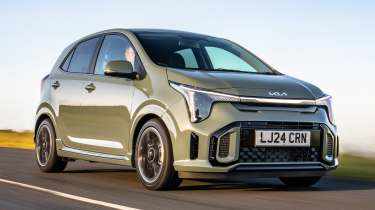
- Prices from £16,065
Pros |
Cons |
|
|
The Kia Picanto is now in its third generation and has developed into a stylish little city car with enough kit to make it genuinely desirable, even before the price is even taken into account. It’s easy to see why the Picanto is so popular because this small car offers tremendous ride quality and the brand’s famous seven-year/100,000-mile warranty, which is a great deal for such a low-priced car.
There are a number of Picanto variants available, but the cheapest is a basic model in 2 trim fitted with a 66bhp 1.0-litre engine and manual gearbox. If you want an automatic gearbox, you’ll have to pay more.
“The latest Picanto is better equipped, has impressive interior space, and a grown-up driving experience.” - Ellis Hyde, news reporter, who drove the Picanto on UK roads
6. Toyota Aygo X
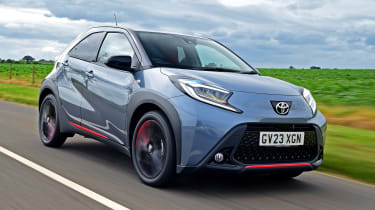
- Prices from £16,845
Pros |
Cons |
|
|
The Toyota Aygo X is something of a pseudo-SUV; it’s essentially a compact city car with beefed-up styling. This design helps this tiny car to stand out, but there’s also a strong level of standard equipment to back up its big-car aspirations. Opting for the entry-level Pure trim will bag you the lowest price, but you’ll still get adaptive cruise control, a seven-inch touchscreen with Apple CarPlay and Android Auto, and Toyota’s Safety Sense package. .
As with most city cars, the Aygo X’s compact size makes it easy to drive and park, and the 1.0-litre three-cylinder engine provides adequate power for this sub-one-tonne car. The powertrain does feel a bit dated when compared with an increasing number of electrified rivals, but it should still achieve more than 55mpg with little fuss.
“Its funky pseudo-SUV looks and sense of fun give the tiny Toyota a certain appeal, and set it apart from the more grown-up contenders in this class. However, the Aygo X simply isn’t as refined, practical or cheap as its closest city car rivals.” - Ellis Hyde, news reporter, who drove the Aygo X in the UK
7. Hyundai i10
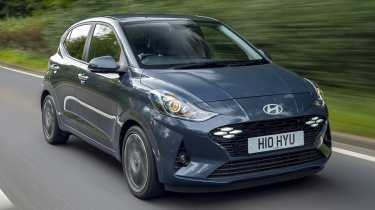
- Prices from £17,100
Pros |
Cons |
|
|
Our two-time City Car of the Year is not only one of the cheapest cars you can buy, but it’s also surprisingly sophisticated for its size. The Hyundai i10 boasts a generous amount of on-board tech, as well as being comfortable to drive and offering plenty of cabin and boot space. It’s even fitted with interior mood-lighting, just like you’d get in a far bigger and pricier Mercedes. A five-year/80,000-mile warranty and Hyundai Roadside Assistance sweeten the deal, too.
The cheapest i10s are fitted with a 66bhp 1.0-litre three-cylinder engine. This unit is sluggish in terms of acceleration but, when you do reach cruising speeds, the compact Hyundai is far more comfortable than most of its rivals.
“Hyundai’s smallest car is more comfortable and refined than ever, while the diminutive size, tight turning circle and light steering make it an absolute doddle to drive around town.” - Ellis Hyde, news reporter, who tested the i10 in the UK
8. MG3

- Prices from £16,995
Pros |
Cons |
|
|
The reborn MG brand has already shaken up the electric car and SUV markets, and now it finally seems to have found its supermini mojo with the second-generation MG3. While cost-cutting to achieve the original model’s low price was painfully obvious in places, the latest car is a vastly improved machine. Not only is it well-equipped and comfortable, but it’s enjoyable to drive, too.
You’ll be looking at the petrol-powered MG3 if you want the very lowest starting price but, if you’re prepared to fork out a couple of extra thousand, we recommend considering the full-hybrid model. With an official WLTP combined economy figure of 64.2mpg, fill-ups will be anything but a common occurrence.
“The MG3 is among the most fun to drive, comfortable and best-equipped cars in its class.” - Alex Ingram, chief reviewer, who tested the MG3 in the UK
9. Citroen C3
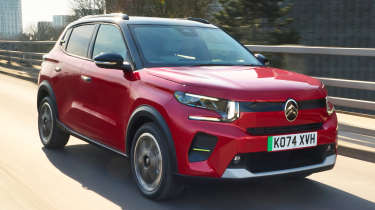
- Prices from £18,305
Pros |
Cons |
|
|
The Citroen e-C3 was our 2024 Car of the Year, but its petrol-powered twin isn’t half bad, either. This pseudo-SUV supermini is practical, affordable and (being a Citroen) pleasingly comfortable. The trade-off is a pretty unexciting driving experience, but for straightforward motoring, the Citroen C3’s price is just about right.
Admittedly, the brand’s cost-cutting efforts are noticeable if you take the time to feel some of the cabin materials, but you will be able to fit four adult passengers inside with little fuss. The 310-litre boot is pretty sizeable for this area of the market.
“At first glance, the Citroen C3 is a pretty unremarkable small car – more comfortable, admittedly, than most of its peers, but not blessed with any dynamic sparkle or, in its electric form, a big battery. However, its cabin is spacious for its size, and it comes with a decent line-up of standard kit.” - John McIlroy, Auto Express contributor, who drove the C3 in the UK
10. BYD Dolphin Surf
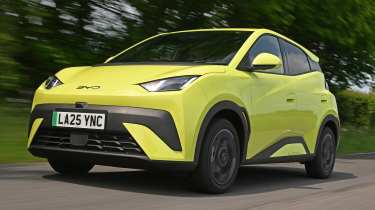
- Prices from £18,650
Pros |
Cons |
|
|
The electric Dolphin Surf is BYD's newest offering here in the UK, and with a starting price of £18,650, decent in-car kit and plenty of range, it’s got all the right ingredients to take on the city car elite.
There’s a choice of two battery options, which can return up to 136 miles or 200 on a WLTP combined cycle – more than sufficient for short journeys and commuting. Plus the car is easy to drive around congested streets and has great all-round visibility. Four adults can comfortably be accommodated, and with a sizable 308 litres, the boot capacity is about 100 litres larger than what’s on offer in the Leapmotor T03.
The Dolphin Surf might be targeted at the budget end of the market, but it’s far from sparse inside. As standard, you get a 10.1-inch electronically rotatable touchscreen, Apple CarPlay and Android Auto phone connectivity, adaptive cruise control and front and rear parking sensors.
“It’s a small car but the BYD Dolphin Surf feels very grown-up when you drive it, more like a larger supermini than a city car.” - Steve Walker, head of digital content, who drove the car in Italy.
What about quadricycles?
You might be thinking that you’ve seen other new cars that are cheaper than the vehicles on our list. However, we’ve restricted ourselves to the legal definition of cars for this list, ignoring the category of vehicles known as quadricycles.
Although quadricycles do have four wheels, they are far smaller and lighter than a typical modern car and are limited to a maximum speed of 28mph. Due to their basic construction, reduced power and small size, quadricycles are much cheaper to buy than a normal car, but they are also much less suited to many drivers’ day-to-day needs. If you rarely use your car, though, and only cover very small distances around town, quadricycle models like the Citroen Ami and Ark Zero can be bought brand-new for as little as £5,500.
Why are these cars so cheap?
Sadly, as with many things, the cost of buying a new car has increased over time. The cheapest full-size new cars today begin at more than £14,000 so, if you’ve got a tighter budget than this, you may be better off looking for a used car.
Of course, if your negotiation skills are top-tier, you may be able to haggle this price down further. What you should remember, though, is that cars in this price bracket should come with a different set of expectations. They’ll get you from A to B for sure, but will they be as economical, practical or well built as something that costs a few grand more? There’s no guarantee.
To achieve those low sticker prices, cheap new cars are often stripped of everything bar the basics and they’ll sometimes feel a little low-rent next to more expensive versions of the same car just a few steps up the trim ladder. Many buyers will happily put up with some blanked-out buttons, downmarket trim finishes or even an underpowered engine, but others will see the extra outlay needed to secure a few more creature comforts as money well spent. Either way, the cheap car’s head-turning sticker price has done its job.
In many instances, the biggest challenge facing cars at the cheap end of the market is the existence of used alternatives offering more kit, a better engine and, often, a more desirable badge for the same money. Again, many people will rather sink their cash into an apparently better car with a few thousand miles on the clock, but the appeal of a brand-new model with a full warranty and finance facilities not always open to used car buyers is still strong.
New car deals



Did you know you can sell your car with Auto Express? Get the highest bid from our network of over 5,500 dealers and we'll do the rest. Click here to try Auto Express Sell My Car now...
